Ganymede
 New Horizons’ LORRI snaps this image of Ganymede, Jupiter’s largest moon from a distance of 3.5 million km (2.2 million miles). Dark patches of ancient terrain are broken up by swaths of brighter, younger material, and the entire icy surface is peppered by more recent impact craters that have splashed fresh, bright ice across the surface. With a diameter of 5,268 kilometers (3,273 miles), Ganymede is the largest satellite in the solar system.
New Horizons’ LORRI snaps this image of Ganymede, Jupiter’s largest moon from a distance of 3.5 million km (2.2 million miles). Dark patches of ancient terrain are broken up by swaths of brighter, younger material, and the entire icy surface is peppered by more recent impact craters that have splashed fresh, bright ice across the surface. With a diameter of 5,268 kilometers (3,273 miles), Ganymede is the largest satellite in the solar system.
Europa
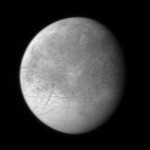 At a distance of 3.1 million km (1.9 million miles), New Horizons’ LORRI takes this picture of Europa. Covered in ice, Europa is about the size of Earth’s moon, with a diameter of 3,130 kilometers (1.945 miles).
At a distance of 3.1 million km (1.9 million miles), New Horizons’ LORRI takes this picture of Europa. Covered in ice, Europa is about the size of Earth’s moon, with a diameter of 3,130 kilometers (1.945 miles).
Little Red Spot
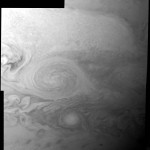 New Horizons’ LORRI snaps a picture of the Little Red Spot from 3 million km (1.8 million miles).
New Horizons’ LORRI snaps a picture of the Little Red Spot from 3 million km (1.8 million miles).
These LORRI images of the Little Red Spot are amazing in their detail. They show the early stages of this newly reddened storm system with a resolution that far surpasses anything available until now.
Io eruption
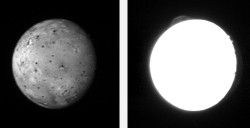 From 4 million km (2.5 million miles) away, New Horizons’ LORRI instrument photos Io’s Tvashtar volcano erupting. Jupiter’s tidal interaction with Io heats it up and causes it to be volcanically active. The bright photo shows Tvashtar erupting a huge dust plume at the 11 o’clock position. The bumps at the 2 o’clock position are tall mountains. The darker photo shows surface features of Io.
From 4 million km (2.5 million miles) away, New Horizons’ LORRI instrument photos Io’s Tvashtar volcano erupting. Jupiter’s tidal interaction with Io heats it up and causes it to be volcanically active. The bright photo shows Tvashtar erupting a huge dust plume at the 11 o’clock position. The bumps at the 2 o’clock position are tall mountains. The darker photo shows surface features of Io.
This is the best image of a large volcanic plume on Io since the Voyager flybys in 1979.
Observes solar wind
New Horizons’ SWAP instrument sends back data on the solar wind around Jupiter. From a distance of 40 million miles, it observes an immense structure of compressed, dense, hot ionized gas that forms in the solar wind, called a co-rotating interaction region.
These solar wind structures collide with the magnetospheres of planets and, we believe, cause major variations in their structures. Because it has the largest magnetosphere in the solar system, the effects of the solar wind at Jupiter could have significant implications for all the planets.
Jupiter rendezvous
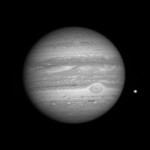 New Horizons rendezvous with Jupiter begins with black-and-white photos of Jupiter and infrared images of its moon Callisto. The probe is 81 million km (50 million miles) from the planet.
New Horizons rendezvous with Jupiter begins with black-and-white photos of Jupiter and infrared images of its moon Callisto. The probe is 81 million km (50 million miles) from the planet.
Our ground team has worked very hard to get to this point. Now the curtain is rising on the next stage of Jupiter-system exploration. It’s exciting!
Sees Pluto
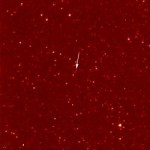 The Long Range Reconnaissance Imager (LORRI) takes its first photos of Pluto from 4.2 billion km (2.6 billion miles) away. At this distance Pluto is just a faint point of light among the stars.
The Long Range Reconnaissance Imager (LORRI) takes its first photos of Pluto from 4.2 billion km (2.6 billion miles) away. At this distance Pluto is just a faint point of light among the stars.
Finding Pluto in this dense star field really was like trying to find a needle in a haystack. LORRI passed this test with flying colors, because Pluto’s signal was clearly detected at 30 to 40 times the noise level in the images.
Jupiter images
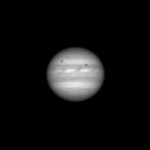 New Horizons probe takes its first pictures of Jupiter with its Long Range Reconnaissance Imager (LORRI) from 291 million km (181 million miles) away.
New Horizons probe takes its first pictures of Jupiter with its Long Range Reconnaissance Imager (LORRI) from 291 million km (181 million miles) away.
LORRI’s first Jupiter image is all we could have expected. We see belts, zones and large storms in Jupiter’s atmosphere. We see the Jovian moons Io and Europa, as well as the shadows they cast on Jupiter. It is most gratifying to detect these moons against the glare from Jupiter.
Tracks asteroid
 In order to test its tracking and imaging capabilities, the probe tracks and photographs asteroid 2002 JF56 in the asteroid belt coming to within 102,000 km. The asteroid is about 2.5 km in diameter.
In order to test its tracking and imaging capabilities, the probe tracks and photographs asteroid 2002 JF56 in the asteroid belt coming to within 102,000 km. The asteroid is about 2.5 km in diameter.
The asteroid observation was a flight test, a chance for us to test the spacecraft’s ability to track a rapidly moving object and to refine our sequencing process. The objects we will observe this winter in the Jupiter system will appear to be moving across the sky much more slowly than this asteroid, so these observations were an unexpected opportunity to prepare for the even faster tracking rates we’ll experience in summer 2015, when the spacecraft zips through the Pluto system at more than 31,000 miles per hour.
The probe is now 283 million km (176 million miles) from Earth traveling at 27 km (17 miles) per second relative to the sun.
Crosses Mars’ orbit
 The probe passes Mars’ orbit. It is now 93.5 million km (58.1 million miles) from Earth traveling at 21 km (13 miles) per second relative to the sun.
The probe passes Mars’ orbit. It is now 93.5 million km (58.1 million miles) from Earth traveling at 21 km (13 miles) per second relative to the sun.
Payload passes tests
Space controllers have tested science instruments on board and confirm that all instruments survived the launch and are working properly.
The instruments are sending back a lot of housekeeping data that says they’re working the way they’re supposed to. The mission science team is just beaming to know that the entire payload survived the stresses of launch in good health.
Third course correction
The probe fires its thrusters again for 76 seconds in order to perfect its path toward Jupiter. It is 51.7 million km (32.1 million miles) from Earth traveling at 37.5 km (23.3 miles) per second.
Second course correction
New Horizons fires its thrusters for twelve minutes to refine its trajectory toward Jupiter. It is 11.9 million km (7.4 million miles) from Earth.
Everything performed as planned. New Horizons has to fly through a precise aim point near Jupiter to get to Pluto on time and on target, and these maneuvers are putting us on the right path.
Course correction
New Horizons performs its first trajectory correction maneuver by firing its thrusters for four minutes 36 seconds to begin bringing it on a path to rendezvous with Jupiter where it will get a gravity assist to speed it on its way to Pluto.
Launch successful
The Atlas V rocket with the New Horizons probe is launched successfully. After 44 minutes and 53 seconds it separates from its solid-fuel kick motor. Five minutes later mission control receives the first signals from the probe that all is well. The fastest probe ever launched is hurtling through space at 36,000 mph on its three billion journey to Pluto. NASA:
Today, NASA began an unprecedented journey of exploration to the ninth planet in the solar system. Right now, what we know about Pluto could be written on the back of a postage stamp. After this mission, we’ll be able to fill textbooks with new information.
Launch delayed again
Severe storms knock out power to the New Horizons mission control center at John Hopkins University in Maryland. Although they have backup power, the team wants to be sure they have enough backup before proceeding with critical operations like launching and early flight operations. They decide to delay the launch for the following day.
We’ve been working on this for 17 years so I don’t think a couple of days are going to hurt us.
Launch delayed
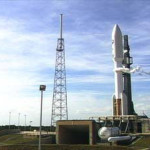 Just two minutes and 42 seconds before the booster engines are to fire, flight controllers halt the launch of the New Horizons probe due to high ground winds which may compromise the safety of the launch. NASA:
Just two minutes and 42 seconds before the booster engines are to fire, flight controllers halt the launch of the New Horizons probe due to high ground winds which may compromise the safety of the launch. NASA:
We chose not to launch today because the ground winds were just a bit too high. The wind limit at the pad is 33 knots [and] we have exceeded that limit several times today.
Payload ready
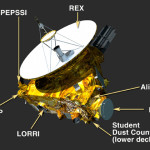 The payload of seven science instruments completes its last major preparations for flight.
The payload of seven science instruments completes its last major preparations for flight.
Although the hard work on the instrument development and testing is over, the work never stops. We’ll only stop worrying once we’ve achieved full mission success, but we’re thrilled that the payload is ready for flight…The New Horizons payload is a remarkably compact, but powerful suite of instruments that will revolutionize our knowledge of Pluto, its large moon Charon and bodies farther out in the Kuiper Belt.
The instruments include:
Alice, an ultraviolet imaging spectrometer that will probe the atmospheric composition and structure of Pluto.
Ralph, a visible and infrared camera that will obtain high-resolution color maps and surface composition maps of the surfaces of Pluto and Charon.
LORRI, or Long Range Reconnaissance Imager, will image Pluto’s surface at football-field sized resolution, resolving features as small approximately 50 yards across.
SWAP, or Solar Wind Around Pluto, will measure charged particles from the solar wind near Pluto to determine whether it has a magnetosphere and how fast its atmosphere is escaping.
PEPSSI, or Pluto Energetic Particle Spectrometer Science Investigation, will search for neutral atoms that escape the planet’s atmosphere and subsequently become charged by their interaction with the solar wind.
SDC, or Student Dust Counter, will count and measure the masses of dust particles along the spacecraft’s entire trajectory, covering regions of interplanetary space never before sampled.
REX, or Radio Science EXperiment, a circuit board containing sophisticated electronics that has been integrated with the spacecraft’s radio telecommunications system, will study Pluto’s atmospheric structure, surface thermal properties, and make measurements of the mass of Pluto and Charon and KBOs.
Probe arrives at Space Center
 The New Horizons one thousand pound probe arrives at the Kennedy Space Center for final preparations and testing before its launch.
The New Horizons one thousand pound probe arrives at the Kennedy Space Center for final preparations and testing before its launch.
Probe shipped
John Hopkins University Applied Physics Laboratory, which built the New Horizons probe, ships it to NASA Goddard Space Flight Center for its next round of pre-launch testing. APL Project manager:
Our testing program is off to a good start. We’ve shown that New Horizons is structurally ready for the ride on the launch vehicle, and now we’ll test it in the full range of conditions it would face on the voyage to Pluto, Pluto’s moon, Charon, and beyond.
